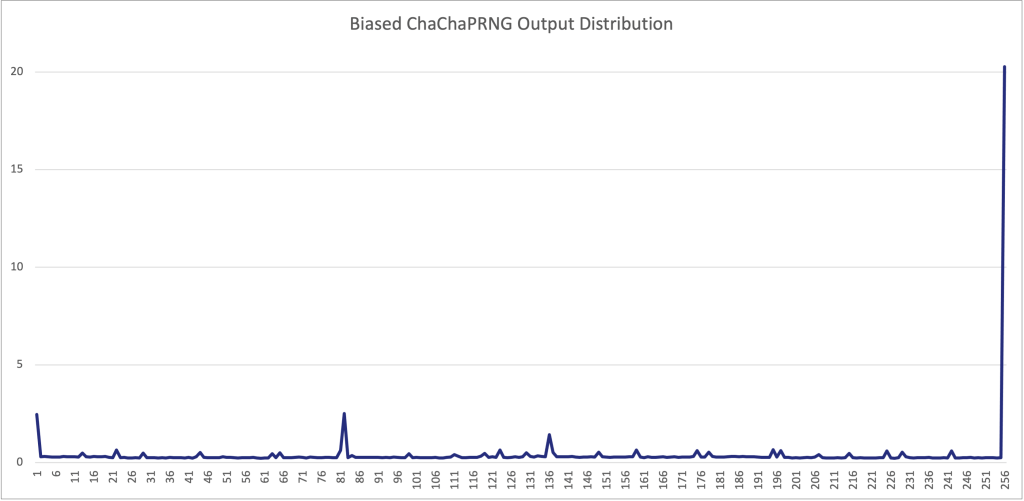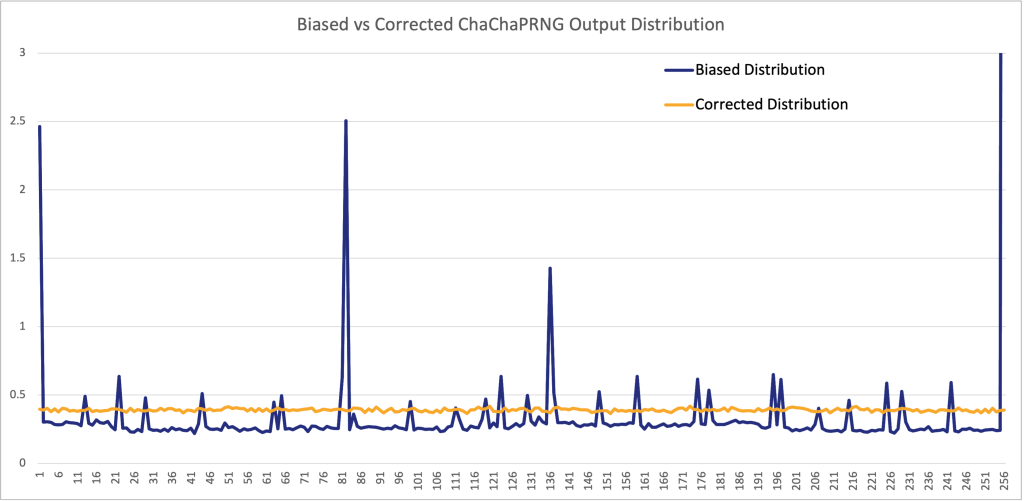Random number generators are the backbone of most cryptographic protocols, the crucial cornerstone upon which the security of all systems rely, yet they remain often overlooked. This blog post presents a real-world vulnerability discovered in the implementation of a Pseudo-Random Number Generator (PRNG) based on the ChaCha20 cipher.
Discovery of a biased PRNG
During a recent engagement, we were tasked with reviewing a ChaCha20-based PRNG, following a design similar to the Rust ChaCha20Rng. The implementation under review was written in Java and a first pass over the source implementation did not reveal any glaring issue.
Similarly, a glance over the output produced by the PRNG seemed normal at first. As an example, the PRNG produced the following 32-byte sequence when seeded with a random seed:
-69, -112, 94, -33, 51, 35, -123, 21, -20, -30, -93, -51, -128, -78, -62, 37, -108, 5, 72, 15, 15, -121, 90, 41, -96, -107, -94, -50, 39, -96, -116, 19
Note that since Java does not support unsigned primitive types, bytes are interpreted in two’s complement representation and a byte can take any value from -128 to 127.
However, when generating longer outputs, some curious patterns started to emerge. Consider the following 128-byte output, seeded with the same random value as before:
-69, -112, 94, -33, 51, 35, -123, 21, -20, -30, -93, -51, -128, -78, -62, 37, -108, 5, 72, 15, 15, -121, 90, 41, -96, -107, -94, -50, 39, -96, -116, 19, 48, 41, 127, -90, -62, -31, -103, -59, -51, 82, 49, 72, 103, -112, 76, -67, 29, -88, 126, -101, -85, -1, -1, -1, 10, 81, 8, -76, -126, -1, -1, -1, -62, -21, 79, 104, -120, 55, -125, -70, 2, 108, -95, 74, -44, 89, -124, -20, 30, 76, -126, 90, 69, -1, -1, -1, 39, -110, -48, -34, 83, -1, -1, -1, 16, 41, 2, 115, -100, 96, 28, -65, -44, -73, 102, -123, 45, -11, -117, -128, 7, -55, -10, -50, -38, -1, -1, -1, 81, 127, -69, -22, 124, 82, 51, 112Starting at byte 54, sequences of triplets of -1 are repeated multiple times, too often for this pattern to be random. Note that -1 is equivalent to the byte value 0xFF (that is, the byte exclusively composed of 1-bits: 0b1111 1111), but Java interprets and displays that value as -1.
Identifying the root cause
Driven by the feeling that something was amiss, we delved into the code once more and eventually narrowed down the faulty code to the rotateLeft32() function, a critical building block of ChaCha20. This function is excerpted below for convenience.
private static int rotateLeft32(int x, int k) {
final int n = 32;
int s = k (n - 1);
return x << s | x >> (n - s);
}At a first glance, this function seems to perform a fairly standard left rotation on 32-bit values. Since Java does not have a primitive type for unsigned integers, this function operates on signed integers. Upon more careful inspection, we discovered something wrong with the right shift operation performed in the return statement of the function. The >> operator used in the function above performs a signed right shift in Java (also known as an arithmetic right shift, or a sign-propagating right shift since it preserves the sign of the resulting number).
When shifting an integer by one with the >> operator, the most significant bit (i.e., the leftmost bit) is not unconditionally replaced by a zero, but by a bit corresponding to the sign bit of the shifted value (0 for a positive integer, 1 for a negative integer). Since the return value of the rotateLeft32() function is computed using a boolean “or” of that shifted quantity, a superfluous 1-bit resulting from shifting a negative input value will be propagated to the output. Hence, the rotateLeft32() function may produce incorrect results when performing the bitwise rotation of negative 32-bit integers.
In contrast, the operator >>> performs an unsigned right shift (or logical right shift) in Java, where the extra bits shifted off to the right are discarded and replaced with zero bits regardless of the sign of the original value. It is this operator that should have been used in the rotateLeft32() function. This subtle difference is very specific to Java. In Rust for example, the type of the value shifted dictates which shift variant to use, as explained in The Rust Reference book, in the section on Arithmetic and Logical Binary Operators:
Arithmetic right shift on signed integer types, logical right shift on unsigned integer types.
Impact
The impact of this issue in the rotation function could already be observed visually by the repeated presence of -1s. In order to understand why using a signed right shift results in an increased probability of generating -1 bytes, let us look at the ChaCha function using that left rotation operation, namely the Quarter Round function, see RFC 7539:
a += b; d ^= a; d <<<= 16;
c += d; b ^= c; b <<<= 12;
a += b; d ^= a; d <<<= 8;
c += d; b ^= c; b <<<= 7;
For each call to the ChaCha Quarter Round function, internal state variables are left-rotated (using the rotateLeft32() function) by some fixed values, as highlighted above. Consider what happens when left-rotating a value with a single 1-bit using the function above. For illustration purposes, we’ll use the value 0x80000000 which corresponds to the quantity 10000000 00000000 00000000 00000000 (split into 8-bit chunks for clarity, and where obvious repeated sequences of 0s are replaced with ...).
rotateLeft32(1000 ... 0000, 16)
= 1000 ... 0000 << 16 | 1000 ... 0000 >> 16
= 00 ... 0 | 1100 ... 0000 >> 15
= 1110 ... 0000 >> 14
= ...
= 11111111 11111111 10000000 00000000
= 0xFFFF8000
= {-1, -1, -128, 0}In this case, a value containing a single 1-bit as input results in an output consisting of seventeen (17) 1s! This helps explain why the output that originally caught our eye contained so many -1 bytes.
The usage of the incorrect shift operation is a damaging bias in the output distribution. To illustrate this bias, the figure below shows a plot of the output distribution of the ChaChaPRNG implementation when seeded with the same seed as in the examples, and used to generate a total of 10,000 32-byte samples. In the figure below, the bytes are normalized to be in the [0, 255] range. The most striking outlier is the value 255 (the -1 discussed previously), which appears with probability over 20%. But other values also have significant biases, such as 0 (which appears with probability 2.46%) or 81 (which appears with probability 2.50%). In a truly random distribution, a given byte should appear with probability 1/256 = 0.390625.

Research has shown that leaking as little as one bit of an ECDSA nonce could lead to full key recovery. Thus, using the output of this PRNG for cryptographic applications could completely break the security of the systems that rely upon it.
The fix
In this instance, the fix was pretty simple. Replacing the right-shift operator in the rotateLeft32() function by an unsigned right shift ( >>> ) did the trick:
return (x << s) | (x >>> (n - s));The figure below shows the “corrected” output distribution after modifications of the rotateLeft32(), with the same number of samples and the same seed as for the first figure. The vertical axis is cut off at the 3% mark to better show the distribution without the visualization being skewed by the higher-percentage 255 output. The corrected output distribution looks much more uniform.

Conclusion
When writing security-critical code, low level details such as bit operations on underlying number representation can have colossal consequences. In this post, we described a real-world case of a single missing “greater-than” character that totally broke the security of the PRNG built on top of the buggy function. This highlights the challenges of porting implementations between languages supporting different primitive types and arithmetic operations.
I’d like to thank Giacomo Pope and Gérald Doussot for their feedback on this post and for their careful review. Any remaining errors are mine alone.
